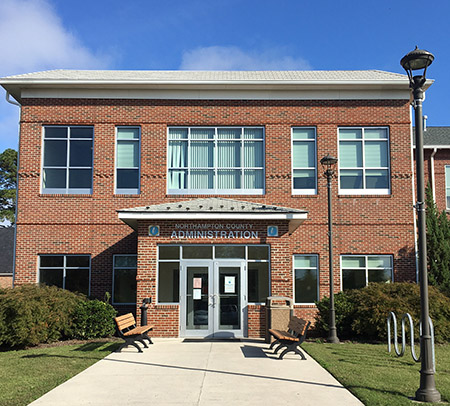By Stefanie Jackson – Northampton supervisors were updated March 9 on the work being performed by ABM Consultants to determine the county’s options for reducing its energy consumption through upgrading county facilities and infrastructure.
Northampton entered a contract with ABM in fall 2020 for the firm to perform a technical audit of county assets such as HVAC systems, indoor air quality, and lighting.
The buildings included in the audit were the courthouse, jail, social services building, county administration building, juvenile and domestic relations building, sheriff’s office, and the former Northampton Middle School.
ABM also evaluated energy and facility improvement needs at school buildings including Kiptopeke Elementary School, Occohannock Elementary School, the school administration building, tech center, bus garage, and maintenance shop.
ABM’s analysis of Northampton’s HVAC assets revealed that 68% of the county’s HVAC equipment is in fair to very poor condition, creating a high capital risk – meaning there is a high risk of catastrophic equipment failure, resulting in costly repairs or replacements.
The school buildings fared worse, with ABM’s analysis concluding that 81% of the school equipment is in poor to very poor condition, with a very high capital risk.
That very high risk was already made evident over the last two years, as corroded water pipes in the ceilings at the elementary schools have leaked and burst, flooding classrooms and causing extensive damage.
ABM determined that the problem with the pipes was not due to poor maintenance but substandard steel from the early 1990s, when Kiptopeke and Occohannock Elementary School were built.
Neither did ABM representatives blame the contractor who built the elementary schools. It was an unfortunate situation that affected not just Northampton schools but much of Virginia Beach, they said.
However, each of Northampton’s elementary schools otherwise has a “good solid structure” and with the right upgrades, the life of the schools can be extended up to 50 years.
One option ABM recommended to make the HVAC systems at the elementary schools more energy efficient is to replace the outdated equipment with geothermal systems.
Water pipes would be installed 300 feet into the ground. At that depth, the ground maintains a temperature of about 50 degrees year round. The water in the pipes is warmed by the surrounding earth and is pumped to the surface, distributing heat throughout the building served. Cool water is returned to the ground to be rewarmed.
ABM also recommends installing solar panels on school grounds and at other county buildings.
The firm reported that solar panel systems, or solar arrays, would cover 92% to 100% of the electricity used by the jail, courthouse, and sheriff’s office, resulting in “net-zero energy consumption” for those facilities.
Supervisor Dixon Leatherbury raised concern over the reliability of solar energy, but ABM has worked with the A&N Electric Cooperative and confirmed that when the solar arrays overproduce, the county would be credited for the additional electricity added to the grid, and it would be covered when the solar arrays underproduce and electricity is taken from the grid.
ABM’s energy and operational solutions could save Northampton County $2.5 million over 20 years, and they could save Northampton County Public Schools $10 million over the same period.
As of March 9, Northampton County Administrator Charlie Kolakowski recommended that the former Northampton Middle School be removed from the ABM project, partly because the projected financial savings that would be gained by upgrading the facility were based on full use of the building, but the old middle school is currently about two-thirds vacant.
Kolakowski also indicated that state funding may be available to upgrade the middle school building.
ABM’s next steps will be to work out financing, finalize the Northampton project, write contracts, and submit the project for legal review, which the firm expected to complete by late April.



